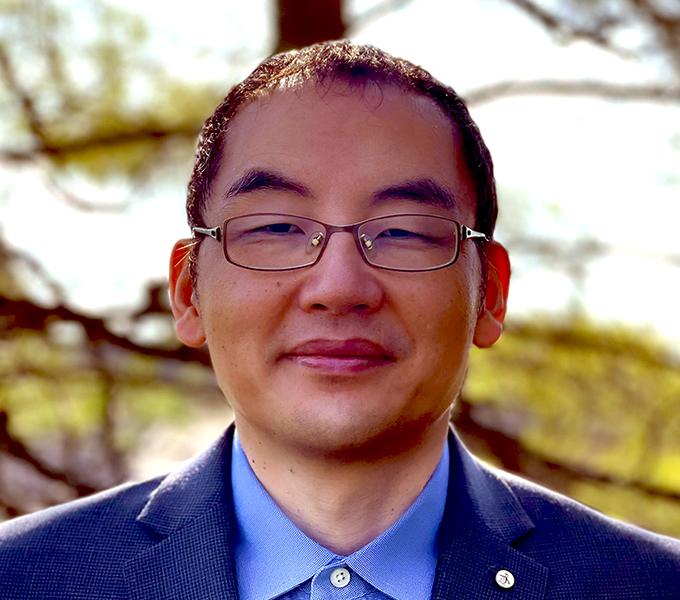In-Kwon Kim is an Associate Professor in the Department of Pharmaceutical Sciences at the University of Pittsburgh. He completed his BS degree at Seoul National University in 1998. Then he received his MS in Microbiology (2000) and Ph.D. in Biochemistry and Structural Biology (2005), both under the supervision of Prof. Sa-Ouk Kang at Seoul National University. In 2006, he joined Prof. Tom Ellenberger's research group at Washington University School of Medicine as a post-doc and was promoted into (Research) Assistant Professor. He was also part of the Washington University Drug Discovery Program.
In 2016, he joined the faculty of the Department of Chemistry at the University of Cincinnati as an Assistant Professor, and was promoted into Associate Professor with tenure in 2022. Before joining the University of Pittsburgh in 2024, he served as Chair of Biochemistry Division and a member of both the University of Cincinnati Cancer Center and Breast Cancer Research Program.
His long-term research goal is the development of novel tumor-selective therapeutics. The Kim lab employs a multi-disciplinary approach, combining structural biology, mechanistic biochemistry, and drug discovery, to investigate the mechanism and function of key enzymes in the ADP-ribosylation cycle and DNA repair. Inhibitors targeting these pathways, such as poly(ADP-ribose) polymerase inhibitors (PARPi: FDA-approved), have shown promise in selectively killing cancers with impaired DNA repair functions. The lab addresses critical biological and biomedical questions: (1) how ADP-ribosylation “writers”, “readers”, and “erasers” (e.g., PARP1, PARG, and ARH3) specifically recognize and process substrates, (2) how ADP-ribosylation interplays with other post-translational modifications, such as ubiquitination (e.g., Deltex E3 ligases), and (3) how we can translate our new findings into the development of novel tumor-selective therapeutics. Notably, his research efforts have successfully led to the identification and a US patent for selective inhibitors of PARG (US Patent: US20220202821A1), a predominant poly(ADP-ribose)-degrading enzyme in humans, as promising alternatives to current FDA-approved PARP inhibitors.
More detailed information can be found in the lab homepage (https://www.inkwonkimlab.com).
Patent:
“Small Molecule PARG inhibitors and Methods of Use Thereof” US Patent: US20220202821A1
Ho, C., Ellenberger, T. Kim, I.K., Jones, D.E., Ahmed, Z., and Tainer, J.A. Pub. No.:
Students* under my direction are indicated by an asterisk.
1. Kelly, M.*, Dietz, C.*, Kasson, S.*, Zhang, Y., Holtzman, M.J., and Kim, I.K. Deltex family E3 ligases specifically ubiquitinate the terminal ADP-ribose of poly(ADP-ribosyl)ation. Biochemical and Biophysical Research Communications. (2024); In press.
2. Kato, J., Yamashita, S., Ishiwata-Endo, H., Oka, S., Yu, Z.X., Liu, C., Springer, D.A., Noguch, A., Peiravi, M., Hoffmann, V., Lizak, M.J., Medearis, M.*, Kim, I.K., and Moss, J. ADP-ribose-acceptor hydrolase 2 (Arh2) deficiency results in cardiac dysfunction, tumorigenesis, inflammation, and decreased survival. bioRvix. (2023); DOI: 10.1101/2023.02.07.527494
3. Pourfarjam, Y.*, Ma, Z.*, and Kim, I.K. ATP enhances the error-prone ribonucleotide incorporation by the SARS-CoV-2 RNA polymerase. Biochemical and Biophysical Research Communications. (2022); 625, 53-59
4. Yang, C.S., Jividen, K., Kamata, T., Dworak, N., Oostdyk, L., Remlein, B., Pourfarjam, Y.*, Kim, I.K., Du, K.P., Abbas, T., Sherman, N.E., Wotton, D., and Paschal, B.M. Androgen signaling uses a writer and a reader of ADP-ribosylation to regulate protein complex assembly. Nature Communications. (2021); 12(1), 2705.
5. Hammel, M., Rashid, I., Sverzhinsky, A., Pourfarjam, Y.*, Tsai, M.S., Ellenberger, T., Pascal, J.M., Kim, I.K.¶, Tainer, J.A.¶, and Tomkinson, A.E.¶ An atypical BRCT-BRCT interaction with human DNA Ligase III compacts the XRCC1 scaffold protein within a flexible DNA repair complex. Nucleic Acids Research. (2021); 49(1), 306-321, PMCID: PMC7797052 (¶: Co-corresponding author)
6. Pourfarjam, Y.*, Ma, Z.*, Kurinov, I., Moss, J., and Kim, I.K. Structural and biochemical analysis of human ADP-ribosyl-acceptor hydrolase 3 (ARH3) reveals the basis of metal selectivity and different roles for the two Mg ions. Journal of Biological Chemistry. (2021); DOI: 10.1016/j.jbc.2021.100692.
7. Moiani, D., Link, T.M., Brosey, C.A., Katsonis, P., Lichtarg, O., Kim, Y., Joachimiak, A., Ma, Z.*, Kim, I.K., Ahmed, Z., Jones, D.E., Tsutakawa, S.E., Tainer, J.A. An efficient chemical screening method for structure-based inhibitors to nucleic acid enzymes targeting the DNA repair-replication interface and SARS CoV-2. Methods in Enzymology. (2021); DOI: 10.1016/bs.mie.2021.09.003
8. Kasson, S.*, Dharmapriya, N.*, and Kim, I.K. Selective monitoring of the protein-free ADP-ribose released by ADP-ribosylation reversal enzymes. PLoS One. (2021); 16(6):e0254022.
9. Ma, Z.*, Pourfarjam, Y.*, and Kim, I.K. Reconstitution and functional characterization of SARS-CoV-2 proofreading complex. Protein Expression and Purification. (2021); DOI: 10.1016/j.pep.2021.105894.
10. Pourfarjam, Y.*, Kasson, S.*, Tran, L.*, Ho, C. and Kim, I.K. PARG has a robust endo-glycohydrolase activity that releases protein-free poly(ADP-ribose) chains. Biochemical and Biophysical Research Communications. (2020); 527(3), 818-823.
11. Houl, J., Ye, Z., Brosey, C., Balapiti-Modarage, L.P.F., Namjoshi, S., Bacolla, A., Laverty, D., Walker, B.L., Pourfarjam, Y.*, Warden, L.S., Chinnam, N.B., Moiani, D., Stegeman, R.A., Chen, M.K., Hung, M.C., Nagel, Z.D., Ellenberger, T., Kim, I.K.¶, Jones, D.E., Ahmed, Z.¶, and Tainer, J.A¶. Selective small-molecule poly(ADP-ribose) glycohydrolase inhibitor causes radiation sensitization, replication fork stalling, and cancer cell death. Nature Communications. (2019); 10 (1), 5654 (¶: Co-corresponding author)
12. Pourfarjam, Y.*, Ventura, J.*, Kurinov, I., Cho, A.*, Moss, J., and Kim, I.K. Structure of human ADP-ribosyl-acceptor hydrolase 3 bound to ADP-ribose reveals a conformational switch that enables specific substrate recognition. Journal of Biological Chemistry. (2018); 293, 12350-12359.
13. Kim, I.K.¶, Stegeman, R.A., Brosey, C.A., and Ellenberger, T.¶. A quantitative assay reveals ligand specificity of the DNA scaffold repair protein XRCC1 and efficient disassembly of complexes of XRCC1 and the poly(ADP-ribose) polymerase 1 by poly(ADP-ribose) glycohydrolase. Journal of Biological Chemistry. (2015); 290, 3775-3783. (¶: Co-corresponding author)
14. Kim, I.K., Kiefer, J.R., Ho, C.M.W., Stegeman, R.A., Classen, S., Tainer, J.A., and Ellenberger, T. Structure of mammalian poly(ADP-ribose) glycohydrolase reveals a flexible tyrosine clasp as a substrate-binding element. Nature Structural & Molecular Biology. (2012); 19, 653-656.
